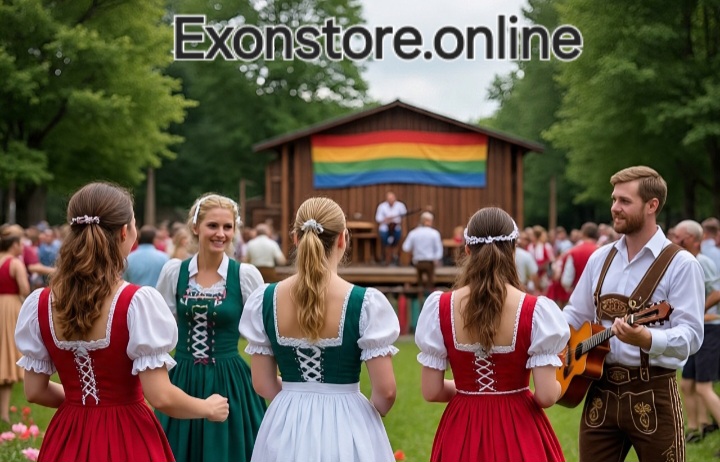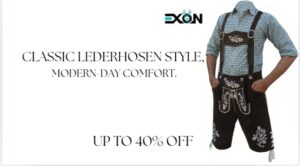Introduction:
The dirndl is more than a dress – it is a symbol of Tradition Fashion elegance, and cultural pride. Worn primarily in the Alpine regions of Germany, Austria, and Switzerland, the dirndl has evolved over centuries while keeping its original charm intact.
Today, it is a fashion statement that bridges the gap between history and modern trends, making it a cherished piece in many wardrobes worldwide.
The Origins of the Dirndl
The dirndl originated in the 19th century as the everyday clothing of rural women in Alpine villages. Made from sturdy fabrics like cotton and linen, it was practical for work in the fields and around the home. Its simple design – a bodice, blouse, full skirt, and apron – made it both functional and comfortable.
Structure and Key Elements
A dirndl consists of four main components:
- Bodice – Fitted and often laced or buttoned, it enhances the waistline and creates a flattering shape.
- Blouse – Usually cropped, with puffed sleeves or lace details, adding softness and femininity to the outfit.
- Skirt – Traditionally knee to ankle length, full and flowing, allowing freedom of movement.
- Apron – Tied around the waist, it’s both decorative and symbolic.
Traditional vs. Modern Dirndls
While the traditional dirndl remains popular Fashion for cultural festivals and events like Oktoberfest, modern variations have transformed it into a versatile fashion piece. Designers now experiment with shorter hemlines, bold colors, luxurious fabrics like silk or velvet, and intricate detailing. These modern dirndls maintain the essence of the classic design while catering to contemporary fashion preferences.
Some dirndls feature daring necklines, corset-style bodices, and unique color combinations that appeal to younger generations. Meanwhile, traditionalists prefer authentic cuts and heritage-inspired patterns that stay true to history.
When and Where to Wear a Dirndl
The most famous occasion for wearing a dirndl is Oktoberfest, the world’s largest beer festival held annually in Munich. However, dirndls are also worn during other folk festivals, weddings, church events, and even formal dinners in Alpine regions. Many women also choose to wear them at themed parties, cultural events abroad, and as a way to connect with their heritage.
Styling the Dirndl
The beauty of the dirndl lies in its adaptability. A soft pastel dirndl with lace trim and a floral crown creates a romantic, fairy-tale look, perfect for weddings or spring festivals. A bold red or deep emerald green dirndl with statement jewelry offers a glamorous vibe. Accessories like traditional necklaces (Kropfketten), embroidered handbags, and elegant shawls can further enhance the look.
Footwear is also important – classic dirndl shoes, comfortable ballet flats, or even ankle boots can complete the outfit. Hair is often styled in braids or pinned up, sometimes adorned with fresh flowers or ribbons.
The Symbolism and Pride of Wearing a Dirndl
For many, wearing a dirndl is not simply about fashion – it is about honoring cultural roots. Each element, from fabric choice to embroidery style, can reflect a specific region’s history. Women who wear a dirndl often speak of feeling both beautiful and empowered, as the design naturally flatters the figure while connecting them to a rich heritage.
Even outside of Germany and Austria, the dirndl has become a global cultural ambassador. At Oktoberfest celebrations around the world – from the USA to Australia – the sight of women in dirndls and men in lederhosen instantly evokes the warmth, hospitality, and festive spirit of Bavarian tradition.
Sustainability and the Future of the Dirndl
With the rise of sustainable fashion, many designers are returning to the roots of dirndl-making by using high-quality, long-lasting materials and artisanal techniques. A well-made dirndl can last for decades and often becomes a treasured family heirloom passed from generation to generation.
The dirndl’s versatility ensures its place in future fashion. Whether styled in a classic or modern way, it remains a garment that can be worn for years without losing its appeal.
Conclusion
The dirndl is more than just clothing – it is a living tradition, a symbol of cultural identity, and a timeless piece of fashion. From its humble beginnings in rural villages to its glamorous appearances at global festivals, the dirndl has proven its enduring charm. Wearing a dirndl is a celebration of heritage, elegance, and individuality, making it one of the most iconic and beloved garments in the world. Whether you prefer a classic, floor-length design or a chic, modern twist, the dirndl continues to enchant with its ability to honor the past while embracing the future.







